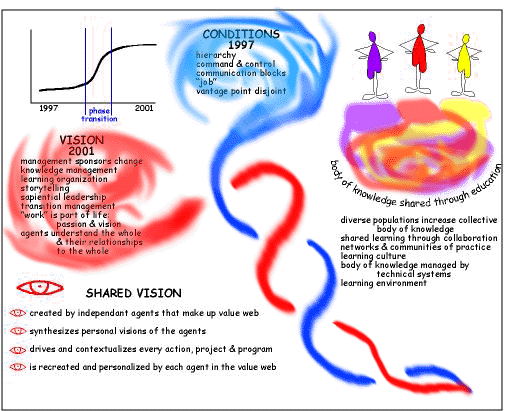
Creating the 21st Century Enterprise
What is the nature of the transition that businesses will undergo to become viable 21st century organizations? The business of 2001 will be a fundamentally different organization from that of 1997, and to achieve that philosophical shift, organizations must submit themselves to a state change, a phase transition.

Hierarchy and bureaucracy dominate the 1997 organization. Control of the organization is understood to reside at the "top" and to filter down through rigid chains of command. These chains of command stifle communication through the organization, and there is inefficient management of knowledge inside the company itself so that frequently information never gets to those people who need it the most. As in a classical factory, workers perform their "jobs" simply to receive a paycheck--"life" goes on outside of the workplace. There exists a delicate balance between employers and employees, each side wanting to get as much as possible from the other while giving as little as possible. As virtual automatons focused on task-level work, workers have no understanding of how their work fits into the larger work of the organization so, to achieve some level of involvement, workers validate their tasks for the tasks' sake, the rules for the rules' sake with little to no thought of what benefit those tasks and rules provide themselves, other workers and the organization as a whole.
In the organization of 2001, individuals engage in their work as an expression of their life's work, thereby engaging their personal visions and passions. The role of management of the organization (a role filled by various individuals depending on the work at hand) is to facilitate ("to make easy") the work of the other individuals in the organization. Management sponsors the changes that are needed to improve the organization, and members of the organization step up to the roles of sapiential leader and transition manager to affect the changes that need to occur. Individuals understand the purpose of the organization and the relationships which their own purposes and the work that they perform have to the organizational purpose. The organization is a learning one and the members of that organization play all five roles of the Five Points of Mastery model. Knowledge is rigorously managed, collected and distributed to ensure that those who need it can access it. The organization as a whole recognizes that it fits into a value web and that only by working for the fitness of the whole web can it ensure its own prosperity.
The shift from the 1997 business to the 2001 enterprise is an example of a phase transition, but what is the nature of this transition? The most well known example of phase transitions is the transition of ice to water at 32 degrees. As water molecules warm up past 32 degrees, they undergo a fundamental change in the nature of their relationships to each other. From the rigid, immobile structures of ice, the water molecules break free to become a nebulous, free-flowing, structureless liquid. Increasing heat (energy) causes the molecules to vibrate more and more. At 32 degrees, the vibrations become stronger than the bonds that hold the individual molecules in place, and the structure breaks apart. We can understand the two endpoints of this transition fairly easily: ice and water. It is the transition itself that proves problematic. What happens BETWEEN the ice state and the water state?
If the environmental conditions stayed precisely at the freezing point of water, at exactly 32 degrees, the water becomes stuck in the transition phase. Looked at very closely, the water/ice combination begins to exhibit interesting phenomena. For instance there will be ice structures that are growing and stretching their way through the water. But there will also be ice structures melting. There might even be structures growing on one end and melting on another. In this solution, individual molecules jump back and forth between liquid and solid, but the entire solution maintains an equilibrium. Ice structures reach out into pools of liquid just as liquid invades ice structures. This intricate dance of conflicting structures is rarely observed since the transition from one state to another is normally rapid, but understanding the nature of this transition can allow one to better navigate the transition itself.
The phase transition for business also juxtaposes two very different states. From the rigid structures of the 1997 hierarchy will emerge a more free-flowing "ad hocracy" in the 2001 organization. Again, the beginning and end states represent seemingly clear distinctions, but the transition period itself is nebulous, uncertain and rapid. Notice, too, that these phase transitions are not gradual. Ice remains ice until the last possible moment, at which point the entire system changes to liquid. In business, too, the changes cannot be incremental. What is implied by the changes described above is not a tweaking or refining of the current system, but rather a fundamental, philosophical shift to a new system, from industrial to organic, from second wave to third, from mechanical to humanistic. In the transition from one philosophy to another, BOTH philosophies will coexist for a time, just as ice and liquid coexist at 32 degrees. The two will interact and feed off of each other.
This is the domain of the Transition Manager. These are the two worlds with which the Transition Manager must be in touch, but must be a part of neither. Partial to neither ice nor water, the Transition Manager's interest lies only in the smooth transition between the two states.
copyright © 1997 MG Taylor Corporation. All Rights Reserved